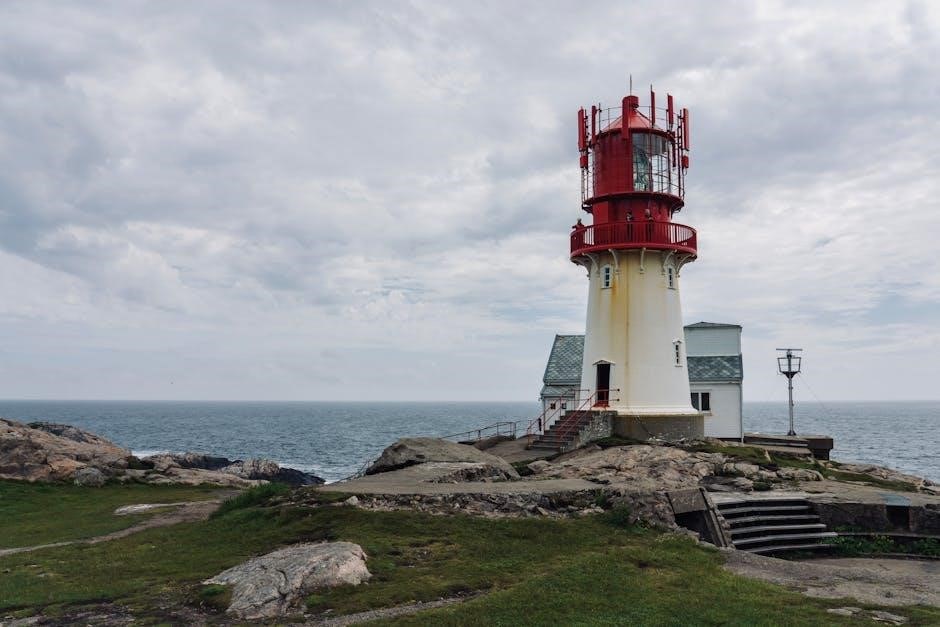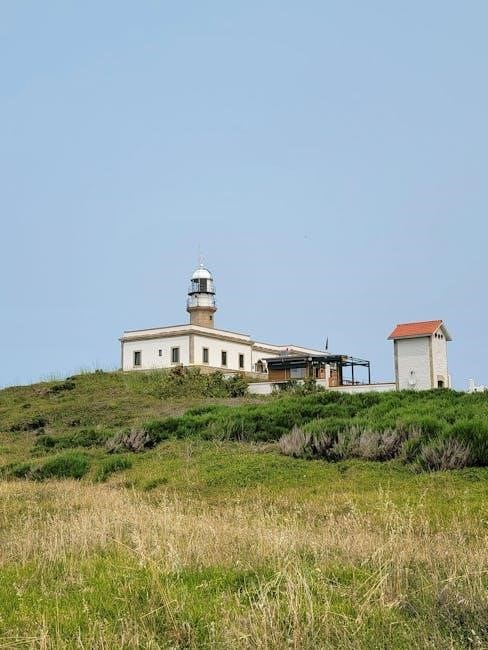
The North Coast 500 is a 516-mile circular route through northern Scotland, covering Inverness-shire, Wester Ross, Easter Ross, Sutherland, Caithness, and the Black Isle, featuring stunning coastal scenery, white sandy beaches, historic castles, and quaint fishing villages.
Overview of the Route
The North Coast 500 is a 516-mile circular route that begins and ends in Inverness, Scotland. It winds through six regions: Inverness-shire, Wester Ross, Easter Ross, Sutherland, Caithness, and the Black Isle. The route is designed to showcase Scotland’s dramatic landscapes, including rugged coastlines, pristine beaches, and historic castles. From the starting point, the journey splits into four main sections: the west coast, north coast, east coast, and back to Inverness. Each section offers unique attractions, such as hidden villages, scenic hikes, and breathtaking vistas. The route is flexible, allowing travelers to explore at their own pace.
Why the North Coast 500 is Scotland’s Most Scenic Drive
The North Coast 500 is renowned for its unparalleled beauty, offering a diverse landscape of rugged coastlines, pristine beaches, and dramatic mountains. This 516-mile route captures the essence of Scotland’s wild and untouched natural beauty. From the crystal-clear waters of the west coast to the dramatic cliffs of the north, every mile reveals a new breathtaking vista. The route also features historic castles, charming fishing villages, and hidden gems waiting to be discovered. Its unique blend of natural splendor and cultural heritage makes it a standout destination for travelers seeking an unforgettable driving experience in Scotland.

Planning Your North Coast 500 Adventure
Plan ahead to secure accommodations early, especially in peak season. Consider camping for flexibility. Proper planning ensures a smooth journey along this 516-mile route.
Best Time to Travel
The best time to embark on the North Coast 500 is during spring (April–June) and autumn (September–October), when the weather is mild and midges are less prevalent. Summer offers long days and warmest temperatures, ideal for outdoor activities, but expect larger crowds. Winter provides a serene, peaceful experience with fewer tourists, though some facilities may be closed. Plan according to your preferences for weather, crowd levels, and activity accessibility. Booking accommodations in advance is crucial, especially during peak seasons. Always check local weather forecasts before your trip to prepare for Scotland’s unpredictable conditions.
How Long Does the Trip Take?
The North Coast 500 typically takes 5 to 7 days to complete, allowing time to enjoy the scenic views, attractions, and activities along the route. While it’s possible to drive the 516-mile journey in less time, 5 to 7 days provides a comfortable pace to explore castles, beaches, and villages without rushing. Some travelers extend their trip to include detours, such as visiting the Isle of Skye, which adds additional days. Planning around accommodation availability, especially during peak seasons, is also important. The duration ultimately depends on your travel style and how much time you wish to spend at each location.
Essential Packing List
Packing for the North Coast 500 requires careful consideration of the region’s rugged terrain and unpredictable weather. Sturdy, waterproof footwear is a must for hiking and exploring. Bring layers of breathable clothing, including a waterproof jacket and warm sweaters for cooler evenings. A reliable map or GPS device is essential for navigating remote areas. Don’t forget a reusable water bottle, power bank for charging devices, and a first-aid kit. Include a camera to capture stunning landscapes and binoculars for wildlife spotting. If camping, pack a sturdy tent and sleeping bag. Lastly, bring snacks and an emergency car kit for long drives.
Breaking Down the Route
The North Coast 500 is a 516-mile circular route through northern Scotland, spanning six regions: Inverness-shire, Wester Ross, Easter Ross, Sutherland, Caithness, and the Black Isle.
Inverness to Lochcarron: The Starting Point
The North Coast 500 begins in Inverness, Scotland’s Highland capital, and winds westward to Lochcarron. This initial stretch offers a gentle introduction to the journey, with scenic views of rolling hills, lochs, and woodlands. The route passes through charming villages, where travelers can stop to explore local culture and history. Lochcarron, known for its picturesque setting and serene atmosphere, marks the first major stop. The journey sets the tone for the adventure ahead, blending natural beauty with opportunities to experience Scotland’s rich heritage. It’s the perfect start to an unforgettable road trip.
West Coast: Lochcarron to Durness
The west coast section of the North Coast 500 is a haven for nature lovers, offering breathtaking coastal vistas and dramatic landscapes. Starting from Lochcarron, the route winds through picturesque villages like Shieldaig and Applecross, where the iconic Bealach na Bà pass provides thrilling views. The journey continues past stunning beaches, such as Achmelvich, and rugged cliffs that overlook the Atlantic Ocean. Durness, with its white sandy beaches and crystal-clear waters, marks the end of this leg. Along the way, visitors can explore ancient castles, hike through scenic trails, or simply soak in the untouched beauty of Scotland’s wild west coast.
North Coast: Durness to John o’ Groats
The north coast section of the North Coast 500 is a dramatic journey through rugged landscapes and breathtaking coastal scenery. Starting in Durness, the route follows the edge of the Atlantic, offering stunning views of the Kyle of Durness and the iconic Smoo Cave; As you traverse the windswept cliffs, hidden beaches, and tiny fishing villages, the landscape becomes increasingly wild and untouched. Reaching John o’ Groats, the northeastern tip of Scotland, you’ll find a sense of adventure and completion. This leg is a perfect blend of natural beauty, history, and solitude, making it a highlight of the NC500 experience.
East Coast: John o’ Groats to Inverness
The final leg of the North Coast 500 takes you from John o’ Groats to Inverness, offering a gentler landscape after the wild north coast. This section winds through picturesque fishing villages, rolling hills, and fertile farmland. Highlights include the Black Isle, known for its scenic views and dolphin spotting at Chanonry Point, and the Cromarty Firth, a haven for wildlife. As you approach Inverness, the capital of the Highlands, the route becomes more serene, with the Moray Firth coastline providing a peaceful conclusion to your journey. This section is a beautiful contrast to the ruggedness of the earlier stages.

Accommodation and Dining
Discover a variety of accommodations, from cozy B&Bs to scenic campsites. Indulge in fresh seafood and local produce at charming restaurants and cafes along the route.
Where to Stay: Hotels, B&Bs, and Camping
Accommodation options along the North Coast 500 range from luxury hotels to charming B&Bs and scenic campsites. Book early, especially during peak season, as demand is high. Hotels offer comfort and amenities, while B&Bs provide a cozy, local experience. For adventure seekers, camping allows immersion in nature, with many sites offering stunning views of the coastline. Popular spots include Lochcarron, Gairloch, and Ullapool. Consider staying in villages like John o’ Groats for a picturesque base. Camping enthusiasts should check facilities in advance, as some sites are remote. Whatever your preference, the NC500 has something to suit every traveler’s needs and budget.
Where to Eat: Local Cuisine and Must-Visit Restaurants
Indulge in Scotland’s fresh seafood and hearty local dishes along the North Coast 500. Must-visit restaurants include The Kylesku Hotel, known for its seafood platters, and The Seafood Restaurant in Ullapool. Don’t miss traditional Scottish fare like Cullen skink and Arbroath smokie. Inverness boasts a vibrant dining scene with award-winning eateries. Local cafes and pubs offer cozy spots for a warm meal or a refreshing pint. Be sure to book in advance, especially during peak season. The NC500 is a culinary journey, with every bite showcasing Scotland’s rich flavors and produce.

Hidden Gems and Activities
Discover remote fishing villages, ancient castles, and breathtaking hikes along the NC500. Explore hidden coves, scenic trails, and wildlife spotting opportunities that showcase Scotland’s untamed beauty.
Off-the-Beaten-Path Attractions
Explore Scotland’s lesser-known treasures along the NC500. Discover Achmelvich Beach, often overlooked despite its turquoise waters; Visit Clachtoll Beach, with its dramatic cliffs and secluded coves. The Stoer Lighthouse, nestled near rugged coastlines, offers breathtaking sunsets. Venture to Smoo Cave, a massive sea cave with ancient history. The hidden village of Lochinver, surrounded by mountains, provides a tranquil escape. For nature lovers, the remote Oldshoremore Beach, with its white sands, is a must-visit. These hidden gems showcase the NC500’s diverse beauty, offering unforgettable experiences for adventurous travelers.
Outdoor Activities Along the Way
The North Coast 500 offers a variety of outdoor activities for all interests. Hike through the rugged landscapes of the Scottish Highlands, with trails like the Balblair MTB Trails and forest hikes at Ledmore & Migdale. For water enthusiasts, kayaking, surfing, or paddleboarding along the stunning coastline is a must. Wildlife spotting is another highlight, with opportunities to see seals, dolphins, and seabirds. Photography buffs will love capturing the dramatic scenery and picturesque villages. The Highland Shooting Centre also provides a unique chance to try clay pigeon shooting; These activities make the NC500 a paradise for outdoor adventurers seeking unforgettable experiences in Scotland’s wild beauty.

Safety and Tips
Explore Scotland’s stunning North Coast 500 safely with essential tips: ensure your vehicle is well-maintained, carry an emergency kit, and respect local wildlife and landscapes.
Driving Safety on Remote Roads
Driving the North Coast 500 requires caution, especially on remote single-track roads. Ensure your vehicle is well-maintained, with a full tank, spare tire, and emergency kit. Be prepared for unpredictable weather and limited phone signal. Reduce speed on narrow bends and use passing places to let oncoming traffic pass. Always pull over safely to allow larger vehicles or emergency services through. Respect wildlife and avoid sudden stops. Keep headlights on for visibility, even in daylight. Familiarize yourself with local driving etiquette to ensure a smooth and safe journey through Scotland’s breathtaking landscapes.
Useful Tips for First-Time Travelers
For first-time travelers tackling the North Coast 500, thorough planning is essential. Book accommodations and popular restaurants in advance, as remote areas have limited options. Allow at least 5-7 days to fully enjoy the route without rushing. Pack layers for unpredictable weather and sturdy footwear for exploring. Keep a portable charger handy due to limited phone signal in remote areas. Respect local wildlife and landscapes by following the Scottish Outdoor Access Code. Consider renting a reliable vehicle suited for single-track roads. Finally, remain flexible and open to spontaneous discoveries—this journey is as much about the experience as the destination.
The North Coast 500 is an unforgettable journey through Scotland’s breathtakingscapes, offering a perfect blend of natural beauty, history, and adventure for every traveler.
Final Thoughts on the North Coast 500 Experience
The North Coast 500 is a journey that captivates the soul, offering breathtaking landscapes, rich history, and unforgettable cultural experiences. From the rugged coastlines to the charming villages, this 516-mile route showcases Scotland’s natural beauty. Whether you’re exploring historic castles, relaxing on pristine beaches, or immersing yourself in local traditions, the NC500 promises an adventure like no other. With proper planning and an open heart, this trip will leave you with lifelong memories and a deeper connection to Scotland’s wild and enchanting Highlands.